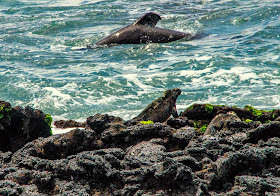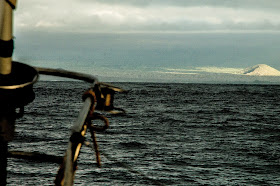 |
Anna, anchored at Puerto Villamil, Isabela's reef-enclosed anchorage.
|
WITH NO SPECIFIC PLAN IN MIND, for visiting the islands in the
Galapagos, we had followed the wind and currents, literally, to arrive
at Isla Isabela, some 88 nm west of Isla San Cristobal, two weeks after
arriving at Isla San
Cristobal. Anna's spade anchor and chain
pulled up clean and untwisted, after residing in the clean water and
sandy bottom of Bahia Baquerizo Moreno. We had decided to sail through
the night, to arrive next morning at the black-lava, reef-enclosed
anchorage off Puerto Villamil, located on the southeast corner of Isla
Isabela.
Anna started out by moving easily along with full sails
set in an 8-knot breeze and a strong, following current, which had
steadily begun to drive her to the north and west of her intended track.
So much so that by the time we were close to half way to Isla Isabela,
as nightfall approached, we had come within two miles of the west side
of Isla Santa Fe - eight miles to the southeast of Isla Santa Cruz; that
is, we had slid twelve nautical miles to the northwest of our intended
course.
Anna was sailing as far south and west as she could
point, yet sliding over the sea with as much as a 3.5 knot current
setting her to the north and west. Eventually, the current shifted 20
degrees to the southwest. It had self-corrected our wayward drift, on
the fly. We had unwittingly made an arc from San Cristobal to Isabela,
adding twelve miles to the rhumbline course.
While navigating under sail power alone, in much of the Galapagos, one must account for a potentially heavy drift, due to the very strong currents that may be encountered. Uncharted, or poorly-charted reefs are another hazard, especially near the coast and in the vicinity of the anchorages. In the dark or fog or an unfavorable sunlight angle, negotiating hidden reefs can be problematic, especially when the accuracy of nautical charts prove unreliable.
We had timed our passage to arrive at Puerto Villamil, Isla Isabel, in the late morning hours so that we could see the black reefs upon entry to the anchorage. We dropped
Anna's sails outside of the more obvious breaking reefs and shoals and then ever so slowly creeped into Villamil, under engine power, at about a knot or less. The tide was high and the sun was obscured in the morning mist when we arrived, and so we had limited visuals on the hidden reefs that surrounded the anchorage. The charts were off by 1/8 of a nautical mile so it appeared that we were moving across land on the electronic navigation charts. And that was a problem, because there were a lot of hidden reefs on the final approach to the anchorage.
We were about 100 feet away from where we thought we would drop the anchor when we felt a distinct, slow-motion, crunching thump. The depth of the water had instantly dropped from 10 feet to less than a foot of depth below the keel, and this was at high tide. We backed up a bit and then tried to slowly turn away from the hidden reef but managed to bump into another close by rock in the process. The good news is that
Anna was moving as slowly as possible when she had made contact with the reef, and she made contact at the best possible angle - dead ahead and low down, where her keel is thickest (a little over a foot thick and lined with an internal ballast of lead).
Anna's third attempt to elude the reefs was successful. We backed up into increasingly deeper water and then slipped over toward the clear, sandy-bottom, where we dropped the hook in 14 feet, below the bottom of
Anna's heavy keel. We noted our entry track on the electronic chart and made offset corrections to the chart on our ThinkPad. We would now be able to escape the reefs without further harm by reversing our track made good, when the time comes, once again, to depart.
***
Isla Isabela
 |
| A ray swims past us, across the sandy bottom at the anchorage. |
 |
| Sea lion and marine iquana, friends, share a warm sandy beach. |
 |
| Pelican, booby, and Galapagos penquins at the anchorage reef. |
 |
| Giant sea turtle glides by us while we snorkel the reefs at Tuneles. | | | | | | | | | | | | |
|
|
|
|
 |
| Cat, snorkeling at Tuneles. |
 |
| Anna approaches Isla Isabela, en route from Isla San Cristobal. |
 |
| Volcanic steam vent on horizon, early morning approach to Isabela. |
|
|
 |
| Anna, en route to Isabela, after passing Isla Santa Fe. |
 |
| Isabela's green landscape on early morning approach to anchorage. |
 |
| Marine iguana swims for the lava rocks in a tidal flush at the reefs. |
 |
| Iquana and sea lion at tidal pool near beach. |
 |
| Cat, taking a stroll past lava reefs. |
 |
| Night heron stalking prey at tidal pool. |
 |
| Anna approaches coastline of Isabel. |
 |
| Snorkeling the reefs at Tuneles we encounter white-tipped sharks. |
 |
| An eagle ray glides by the reefs as we snorkel Tuneles. |
 |
| Rich, drift-snorkeling at Tuneles. |
 |
| Sea horses can be spotted at the reef at Tuneles. |
 |
| Snorkeling the tunnels and caves and arches at Tuneles. |
 |
| Galapagos albatross glide low across the island channels. |
 |
| Dynamic cloud formations, early morning, on approach to Isabela. |
 |
| Galapagos flamingo, at Poza Salinas. |
 |
| Marine iquana swimming near Poza Puerta del Jeli's rose-colored water. |
 |
| Giant land tortoise on southern end of Isabela. |
 |
| Wall of Futility: built by island prisoners as hard labor punishment, 1959-1972. |
|
|
|
 |
| Los Tuneles at low tide. |
 |
| Young, blue-footed booby (with pale feet). |
 |
| Blue-footed booby with pale blue feet means she has recently mated. |
 |
| Male blue-footed booby with bright blue feet is looking for a breeding mate. |
 |
| Cemetery at Puerto Villamil, with black lava rock wall, off white sand beach. |
 |
| Morning clouds off Isla Isabela. |
 |
| The outboard of choice: Yamaha Enduro, favored by all Latino fishermen. |
 |
| Isabela's church tower. |
 |
| Ocean reefs are formidable hazards to navigation in the Galapagos. |
***
Isla San Cristobal
 |
| Blue-footed booby at sea cove near southwestern tip of Isla San Cristobal. |
 |
| Cat, trekking through the garua (mist) at crater lagoon, atop San Cristobal. |
 |
| Green highlands, looking out to sea, on San Cristobal. |
 |
| The alto-plano, San Cristobal, near dormant, volcanic crater. |
 |
| The lush alto-plano region. |
 |
| Rocky, aquamarine sea coast, near Bahia Baquerizo Moreno |
 |
| Old crater lagoon, atop San Cristobal. |
 |
| Sea tortoise swimming at anchorage on Cristobal. |
 |
| Giant land tortoise in the alto-plano. |
 |
| Volcanic landscape and ice plants near the harbor. |
 |
| Marine iquanas roam the black lava beaches and reefs. |
 |
| Sea lions are prolific on San Cristobal's shorelines. |
 |
| Scrub, lava rock, and white sand landscape, at the lower elevations. |
 |
| Yellow warbler in the thickets near the coastline. |
 |
| Tropical fish at the reefs along the anchorage. |
 |
| Mossy trees add to a lush landscape on Cristobal, one of the oldest islands. |
 |
| Lava rocks, green brush, gray scrub, and white sand surround the island. |
 |
| Three giant wind turbines supply 50% of San Cristobal's energy demand. |
 |
| Grassy, willowy, flowering trees abound the landscape. |
 |
| Kicker Rock, in the distance, has a 400 ft. wall - amazing snorkeling. |
 |
| Anna, sitting patiently at anchor, at San Cristobal |
***
























































Fabulous pictures!
ReplyDelete